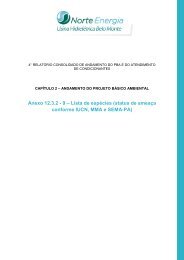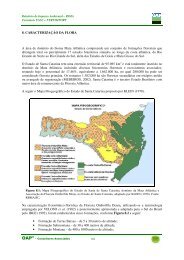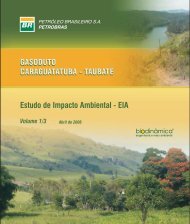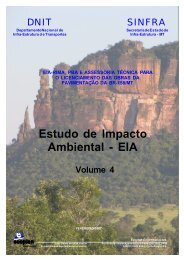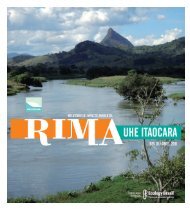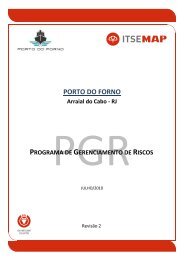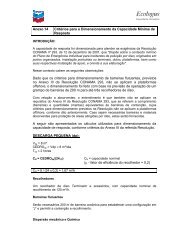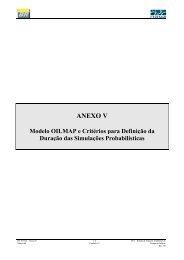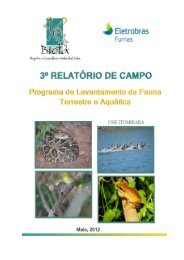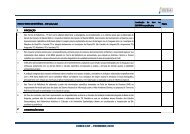- Page 1 and 2:
P R O J E T O P A R N A Í B A Estu
- Page 3 and 4:
APRESENTAÇÃO O Estudo de Impacto
- Page 5 and 6:
Tomo III - Área de Influência Dir
- Page 7 and 8:
8.4. APTIDÃO AGRÍCOLA DAS TERRAS
- Page 9 and 10:
9.2.2 Metodologia de Diagnóstico 9
- Page 11 and 12:
8. ÁREA DE INFLUÊNCIA DIRETA (AID
- Page 13 and 14:
Figura 8.1-2 Arenito subarcosiano c
- Page 15 and 16:
8.1.3. Estudos Sismológicos 8.1.3.
- Page 17 and 18:
7 Rio Aragu aia + A B + + + + + + +
- Page 19 and 20:
Em alguns anos, o número de sismos
- Page 21 and 22:
tanto nas áreas dos eixos como nas
- Page 23 and 24:
Esse maciço é formado por sedimen
- Page 25 and 26:
Quadro 8.1-2 Estimativa do coeficie
- Page 27 and 28:
Foram executadas na área quatro so
- Page 29 and 30:
Os dados fornecidos pelo CECAV não
- Page 31 and 32:
Na AID do AHE Estreito, o neossolo
- Page 33 and 34:
Tabela 8.3-2 Distribuição absolut
- Page 35 and 36:
Quadro 8.4-1 Distribuição absolut
- Page 37 and 38:
mapeamento, encontram-se expressos
- Page 39 and 40:
de solo e formação geológica; co
- Page 41 and 42:
Quadro 8.6-1 Divisão de Queda do E
- Page 43 and 44:
Quadro 8.6-3 Seções Topobatimétr
- Page 45 and 46:
8.6.4. Aspectos Metodológicos A es
- Page 47 and 48:
Descarga Líquida (m 3 /s/km 2 ) 0,
- Page 49 and 50:
• Rio Parnaíba na Estação Fluv
- Page 51 and 52:
principais, até poucos metros, qua
- Page 53 and 54:
(C) (D) (E) (F) (G) Figura 8.6-2 Im
- Page 55 and 56:
Barragem de Boa Esperança e a Foz,
- Page 57 and 58:
Quadro 8.6-12 Diâmetro do Sediment
- Page 59 and 60:
% QUE PASSA 100 90 80 70 60 50 40 3
- Page 61 and 62:
A = Área da seção transversal mo
- Page 63 and 64:
por equações de transporte sólid
- Page 65 and 66:
γ - peso específico da água γs
- Page 67 and 68:
LEGENDA: RESERVATÓRIO EM ESTUDO ES
- Page 69 and 70:
) Vazões com período de retorno e
- Page 71 and 72:
Quadro 8.6-14 Dados da Estação Fl
- Page 73 and 74:
Equação de Ackers-White (1973).
- Page 75 and 76:
Perfil do fundo do rio (m) 75 70 65
- Page 77 and 78:
Perfil do fundo do rio (m) 70 65 60
- Page 79 and 80:
8.6.10. Considerações Referentes
- Page 81 and 82:
À medida que se desloca para jusan
- Page 83 and 84:
• Cálculo do deflúvio sólido m
- Page 85 and 86:
Anexo I Documentação Fotográfica
- Page 87 and 88:
Foto 8.2-3 Vales pedimentados com r
- Page 89 and 90:
8.7. BIBLIOGRAFIA CONSULTADA AGÊNC
- Page 91 and 92:
CRUZ, W. B.; ABOARRAGE, A. M.; SANT
- Page 93 and 94:
HIDROWEB. Base de dados hidrológic
- Page 95 and 96:
Projeto Parnaíba AHE ESTREITO EIA
- Page 97 and 98:
levantamentos serviu de subsídio p
- Page 99 and 100:
carnaúba é observada, enquanto qu
- Page 101 and 102:
Tabela 9.1.4-3: Relação das Espé
- Page 103 and 104:
As famílias com maior número de i
- Page 105 and 106:
Tabela 9.1.3-4. Parâmetros fitosso
- Page 107 and 108:
Gráfico 9.1.4-3 - Distribuição d
- Page 109 and 110:
Caesalpiniaceae, 58 indivíduos (9,
- Page 111 and 112:
Tabela 9.1.4-5. Parâmetros fitosso
- Page 113 and 114:
Gráfico 9.1.3-7 Distribuição dos
- Page 115 and 116:
Pelo resultado das análises granul
- Page 117 and 118:
Gráfico 9.1.4-9. Curva de acumula
- Page 119 and 120:
Tabela 9.1.4-9. Compilação de dif
- Page 121 and 122:
Por meio da análise de similaridad
- Page 123 and 124:
A segunda divisão do TWISNPAN sepa
- Page 125 and 126:
Eixo 2 Mart med Guet spr Vite pan C
- Page 127 and 128:
Projeto Parnaíba AHE ESTREITO EIA
- Page 129 and 130:
Foto 9.1.4 -3 Aspecto da Floresta A
- Page 131 and 132:
Foto 9.1.4 -6 Mata Ciliar nas marge
- Page 133 and 134:
Foto 9.1.4 -10: Sub-bosque da Esta
- Page 135 and 136:
CASTRO, A.A.J.F.; CASTRO, N.M.C.F.;
- Page 137 and 138:
MMA. Avaliação e ações priorit
- Page 139 and 140:
9.1.5. FAUNA 9.1.5.1. Avifauna 9.1.
- Page 141 and 142:
Tabela 9.1.5.1-1 Pontos amostrados
- Page 143 and 144:
Dentre as espécies registradas na
- Page 145 and 146:
Observou-se um número significativ
- Page 147 and 148:
Tabela 9.1.5.1-2 Listagem de Espéc
- Page 149 and 150:
Tabela 9.1.5.1-2 Listagem de Espéc
- Page 151 and 152:
Tabela 9.1.5.1-2 Listagem de Espéc
- Page 153 and 154:
Tabela 9.1.5.1-2 Listagem de Espéc
- Page 155 and 156:
Tabela 9.1.5.1-2 Listagem de Espéc
- Page 157 and 158:
Tabela 9.1.5.1-2 Listagem de Espéc
- Page 159 and 160:
Projeto Parnaíba AHE ESTREITO EIA
- Page 161 and 162:
Foto 9.1.5.1-3 - Floresta Ciliar no
- Page 163 and 164:
9.1.5.1.5. Referências Bibliográf
- Page 165 and 166:
WEGE, D.C. & LONG A. J. 1995. Key A
- Page 167 and 168:
Todas as espécies com maior freqü
- Page 169 and 170:
Nº Espécies Nº E spécies Nº Es
- Page 171 and 172:
A composição de espécies por tip
- Page 173 and 174:
das técnicas também prover result
- Page 175 and 176:
Tabela 9.1.5.2-9 Lista preliminar d
- Page 177 and 178:
Tabela 9.1.5.2-9. Lista preliminar
- Page 179 and 180:
Tabela 9.1.5.2-9. Lista preliminar
- Page 181 and 182:
Tabela 9.1.5.2-9. Lista preliminar
- Page 183 and 184: Tabela 9.1.5.2-9. Lista preliminar
- Page 185 and 186: Tabela 9.1.5.2-9b. . Lista prelimin
- Page 187 and 188: Tabela 9.1.5.2-9b. . Lista prelimin
- Page 189 and 190: Mata Atlântica Caatinga Cerrado Am
- Page 191 and 192: Tabela 9.1.5.2-11. Freqüência de
- Page 193 and 194: influência direta e indireta dos r
- Page 195 and 196: Anexo IV Documentação Fotográfic
- Page 197 and 198: Foto 9.1.5.2-3 Cerdocyon thous - ES
- Page 199 and 200: 9.1.5.2.5. Referências Bibliográf
- Page 201 and 202: 9.1.5.3. Herpetofauna 9.1.5.3.1. M
- Page 203 and 204: que levassem até o local. Mata com
- Page 205 and 206: Tabela 9.1.5.3-2 Espécies da herpe
- Page 207 and 208: 18 16 14 12 10 8 6 4 2 0 1a campanh
- Page 209 and 210: Tabela 9.1.5.3-3 Espécies de anfí
- Page 211 and 212: Portanto, a herpetofauna da AID pod
- Page 213 and 214: número de espécies em atividade.
- Page 215 and 216: 90 80 70 60 50 40 30 20 10 0 Gráfi
- Page 217 and 218: seca de relevo rebaixado na conflu
- Page 219 and 220: Por outro lado, já foi mencionado
- Page 221 and 222: Riqueza (Índice de confiança = 95
- Page 223 and 224: Anexo V Documentação Fotográfica
- Page 225 and 226: Foto 9.1.5.3-3 Ponto 91’ (AQ). Ca
- Page 227 and 228: Foto 9.1.5.3-7 Leptodactylus macros
- Page 229 and 230: Foto 9.1.5.3-11 Eupemphix nattereri
- Page 231 and 232: Foto 9.1.5.3-15 Pseudopaludicola cf
- Page 233: Foto 9.1.5.3-19 Tropidurus hispidus
- Page 237 and 238: R. O. Bierregaard Jr. (eds.). Tropi
- Page 239 and 240: INSERIR MAPA DE PONTOS DE COLETA (P
- Page 241 and 242: Precipitação (mm) 25 20 15 10 5 0
- Page 243 and 244: Características Físicas Químicas
- Page 245 and 246: A resolução 357/2005 do CONAMA de
- Page 247 and 248: Cor (mg Pt/L) 1800 1600 1400 1200 1
- Page 249 and 250: • Dureza A dureza é definida com
- Page 251 and 252: Fosfato Orgânico (mg/L) 0,35 0,3 0
- Page 253 and 254: • Mercúrio (Hg) O mercúrio é e
- Page 255 and 256: As concentrações de nitrogênio n
- Page 257 and 258: OD (mg/L) 7 6 5 4 3 2 1 0 EST-08 ES
- Page 259 and 260: Seguindo-se a resolução de 2005 d
- Page 261 and 262: • Clorofila a A clorofila-a é o
- Page 263 and 264: Tabela 9.2.4.1-2 Índice de Qualida
- Page 265 and 266: O Gráfico 9.2.4.1-28 apresenta o r
- Page 267 and 268: Tabelas 9.2.4.1-3 Parâmetros Físi
- Page 269 and 270: 9.2.4.2 Qualidade dos Sedimentos Na
- Page 271 and 272: A segunda classe mais representativ
- Page 273 and 274: Dentre as Zygnemaphyceae, Mougeotia
- Page 275 and 276: Tabela 9.2.4.3-2 Distribuição Esp
- Page 277 and 278: Tabela 9.2.4.3-2 Distribuição Esp
- Page 279 and 280: Percentagem 100% 80% 60% 40% 20% 0%
- Page 281 and 282: Gráfico 9.2.4.3-6 Análise de agru
- Page 283 and 284: Composição Taxonômica Tabela 9.2
- Page 285 and 286:
) Zooplâncton Presente em todos os
- Page 287 and 288:
O Gráfico 9.2.4.3-7 ilustra a riqu
- Page 289 and 290:
Tabela 9.2.4.3-6 Distribuição Esp
- Page 291 and 292:
Tabela 9.2.4.3-6 Distribuição Esp
- Page 293 and 294:
Tabela 9.2.4.3-7 Densidade Numéric
- Page 295 and 296:
Tabela 9.2.4.3-7 Densidade Numéric
- Page 297 and 298:
Tabela 9.2.4.3-7 Densidade Numéric
- Page 299 and 300:
Os Gráficos 9.2.4.3-8 a e b mostra
- Page 301 and 302:
5,00 4,00 3,00 2,00 1,00 0,00 1ª 2
- Page 303 and 304:
A distribuição e abundância dos
- Page 305 and 306:
Os hemípteros aquáticos são orga
- Page 307 and 308:
N°de Taxa 40 36 32 28 24 20 16 12
- Page 309 and 310:
Tabela 9.2.4.3-11 Distribuição Es
- Page 311 and 312:
Tabela 9.2.4.3-11 Distribuição Es
- Page 313 and 314:
- Análise Quantitativa A avaliaç
- Page 315 and 316:
100% 90% 80% 70% 60% 50% 40% 30% 20
- Page 317 and 318:
Gráfico 9.2.4.3-18 Dendograma de S
- Page 319 and 320:
Tabela 9.2.4.3-11 Densidade Numéri
- Page 321 and 322:
Tabela 9.2.4.3-12 Densidade Numéri
- Page 323 and 324:
Tabela 9.2.4.3-12 Densidade Numéri
- Page 325 and 326:
Tabela 9.2.4.3-14 Densidade Numéri
- Page 327 and 328:
Tabela 9.2.4.3-16 Densidade Numéri
- Page 329 and 330:
Tabela 9.2.4.3-17 Comparação entr
- Page 331 and 332:
ponto EST-6 (Rio Parnaíba a montan
- Page 333 and 334:
Semelhante a comunidade zooplanctô
- Page 335 and 336:
Tabela 9.2-1. Densidade numérica (
- Page 337 and 338:
Tabela 9.2-2. Densidade numérica (
- Page 339 and 340:
Tabela 9.2-3. Densidade numérica (
- Page 341 and 342:
Tabela 9.2-3. Densidade numérica (
- Page 343 and 344:
Tabela 9.2-4. Densidade numérica (
- Page 345 and 346:
Tabela 9.2-4. Densidade numérica (
- Page 347 and 348:
Tabela 9.2-5. Densidade numérica (
- Page 349 and 350:
Tabela 9.2-5. Densidade numérica (
- Page 351 and 352:
Tabela 9.2-7. Densidade numérica (
- Page 353 and 354:
Tabela 9.2-9. Densidade numérica (
- Page 355 and 356:
Tabela 9.2-10. Densidade numérica
- Page 357 and 358:
Tabela 9.2-11. Densidade numérica
- Page 359 and 360:
9.2.5 Referências Bibliográficas
- Page 361 and 362:
Agostinho, A. A.; Gomes, L. C. & Th
- Page 363 and 364:
9.3. ECOSSISTEMAS AQUÁTICOS - VERT
- Page 365 and 366:
• Estação ES-03 Localizada no r
- Page 367 and 368:
a. Estudos para o diagnóstico ambi
- Page 369 and 370:
Tabela 9.3.1-3 Abundância ictíica
- Page 371 and 372:
Tabela 9.3.1-4 Espécies coletadas
- Page 373 and 374:
Tabela 9.3.1-6 Dados biométricos e
- Page 375 and 376:
Dentro da família Characidae, algu
- Page 377 and 378:
Tabela 9.3.1-7 Lista de espécies e
- Page 379 and 380:
Tabela 9.3.1-7 Lista de espécies e
- Page 381 and 382:
Tabela 9.3.1-7 Lista de espécies e
- Page 383 and 384:
Tabela 9.3.1-8 Classificação esp
- Page 385 and 386:
Isto é um problema, pois, a polui
- Page 387 and 388:
• Estação EST-06 Estação loca
- Page 389 and 390:
Participaçao relativa (%) 100% 90%
- Page 391 and 392:
(épocas e áreas de desova; abund
- Page 393 and 394:
Foto 9.3.1-1 Vista da barragem no r
- Page 395 and 396:
Foto 9.3.1-5 Vista da estação de
- Page 397 and 398:
A B Foto 9.3.1-9 A.Rede cônico-cil
- Page 399 and 400:
Cyphocharax gilbert Triportheus sig
- Page 401 and 402:
Serrasalmus brandtii Pygocentrus na
- Page 403 and 404:
Geophagus parnaibae Plagioscion squ
- Page 405 and 406:
Curimata cyprinoides (branquinha) -
- Page 407 and 408:
Hasssar affinis - Macho I Hasssar a
- Page 409 and 410:
Leporinus sp. Fêmea II Fêmea IV M
- Page 411 and 412:
Triportheus singnatus (sardinha) -
- Page 413 and 414:
Macho IV Serrasalmus sp. Projeto Pa
- Page 415 and 416:
Fêmea II Projeto Parnaíba AHE EST
- Page 417 and 418:
Canoas usadas pelos pescadores. Den
- Page 419 and 420:
Projeto Parnaíba AHE ESTREITO EIA
- Page 421 and 422:
Pescador mirim (8 anos) que já con
- Page 423 and 424:
Pescadores entrevistados da colôni
- Page 425 and 426:
AHEs do rio Parnaíba Caracterizaç
- Page 427 and 428:
Projeto Parnaíba AHE ESTREITO EIA
- Page 429 and 430:
9.3.2. Referências Bibliográficas
- Page 431 and 432:
COSTA, W. J. E. M. & G. C. BRASIL.
- Page 433 and 434:
Comparative Zoology 36:1-515. 1913.
- Page 435 and 436:
MIRANDA-RIBEIRO, A. DE. Sobre uma c
- Page 437 and 438:
Brasil - Relatório Final. Campinas
- Page 439 and 440:
Equipe Técnica
- Page 441 and 442:
CREA 060102244-D Cadastro Técnico
- Page 443 and 444:
• Geoprocessamento Maria Aparecid
- Page 445 and 446:
Leandro A. dos Santos Abade Biólog
- Page 447 and 448:
Bióloga Cadastro Técnico Federal
- Page 449 and 450:
Paula Almeida Estagiária Cadastro
- Page 451 and 452:
Sandra Reis De Araújo Bióloga Cad
- Page 453 and 454:
Margareth Grillo Teixeira Bióloga,
- Page 455 and 456:
Joana Feitosa Fraga dos Santos Assi




